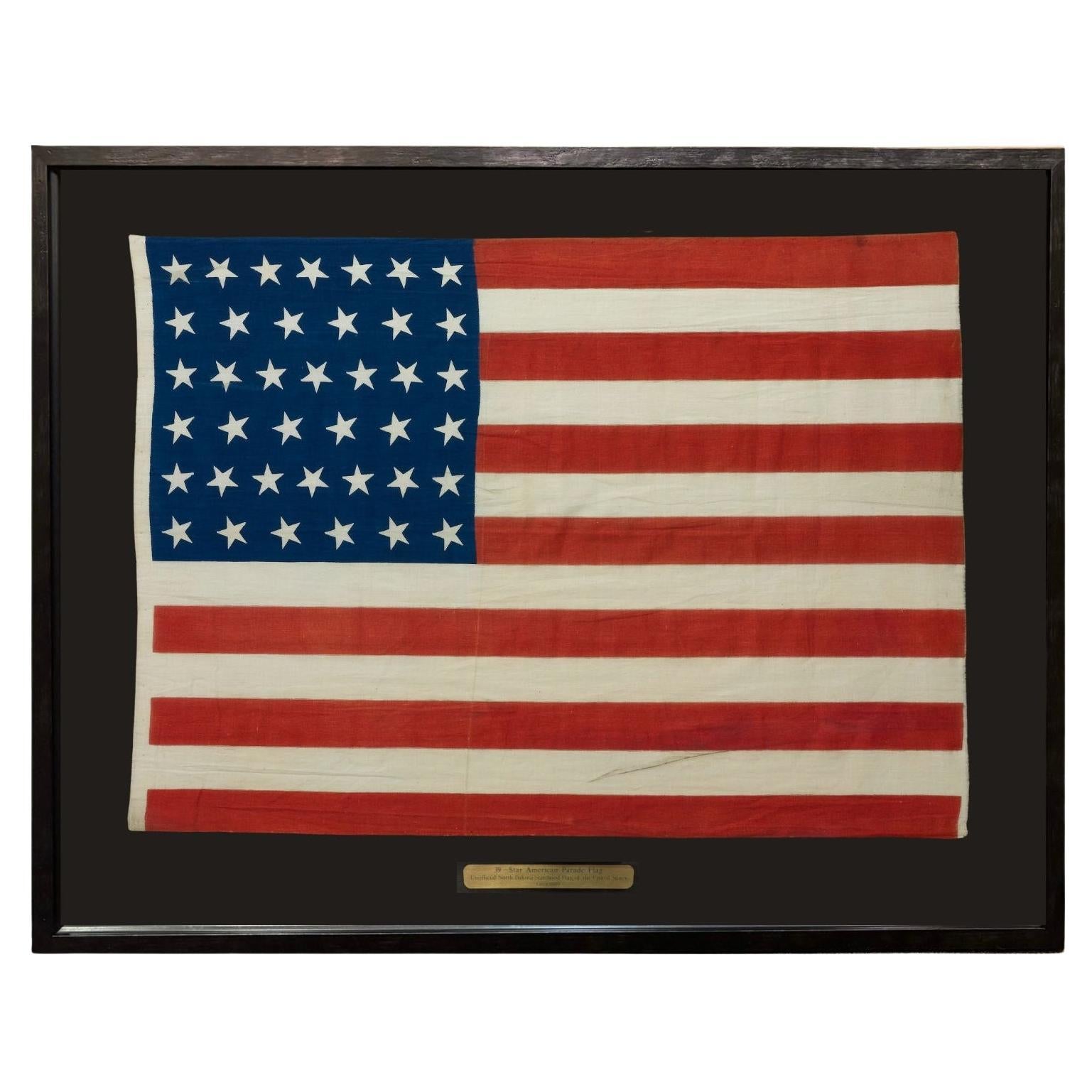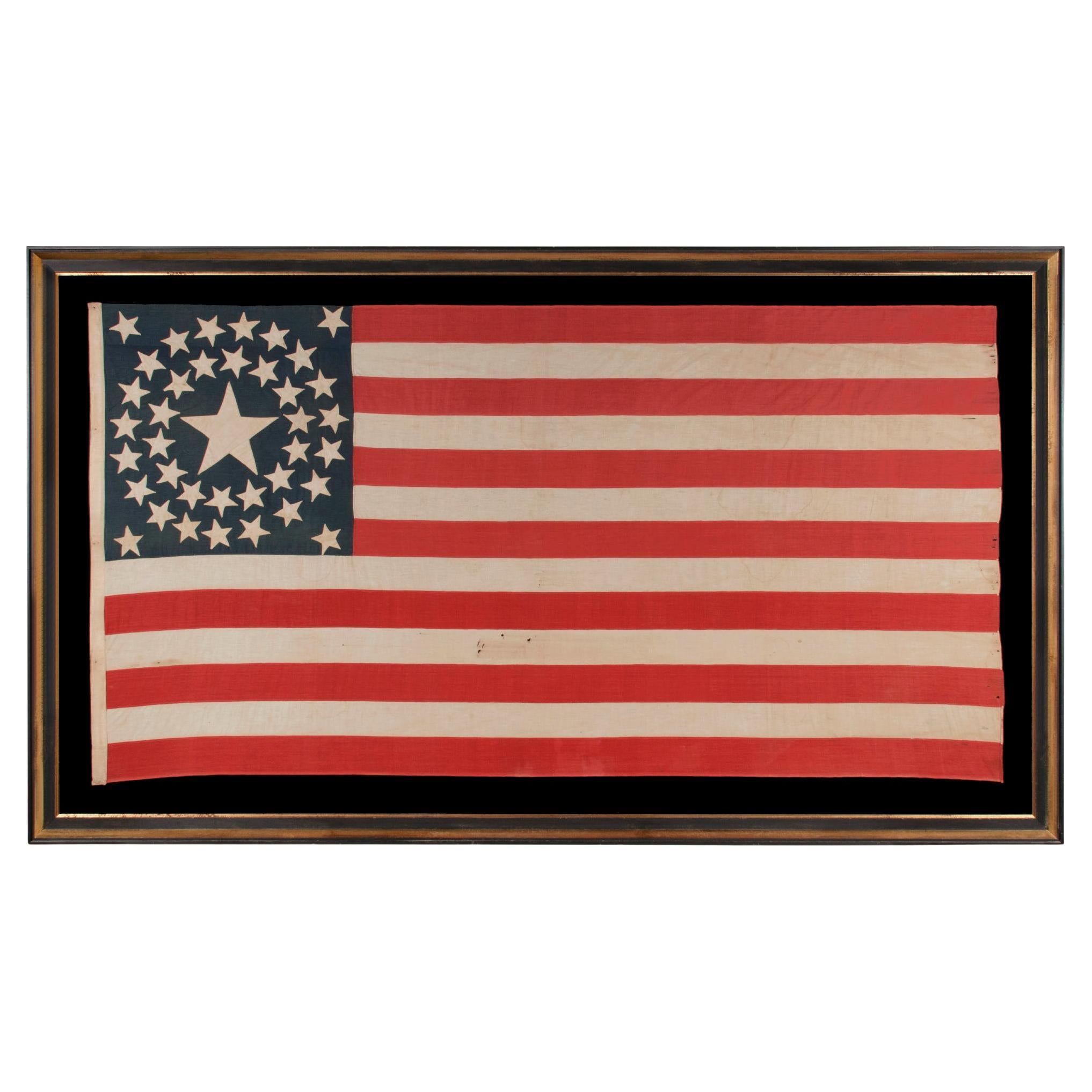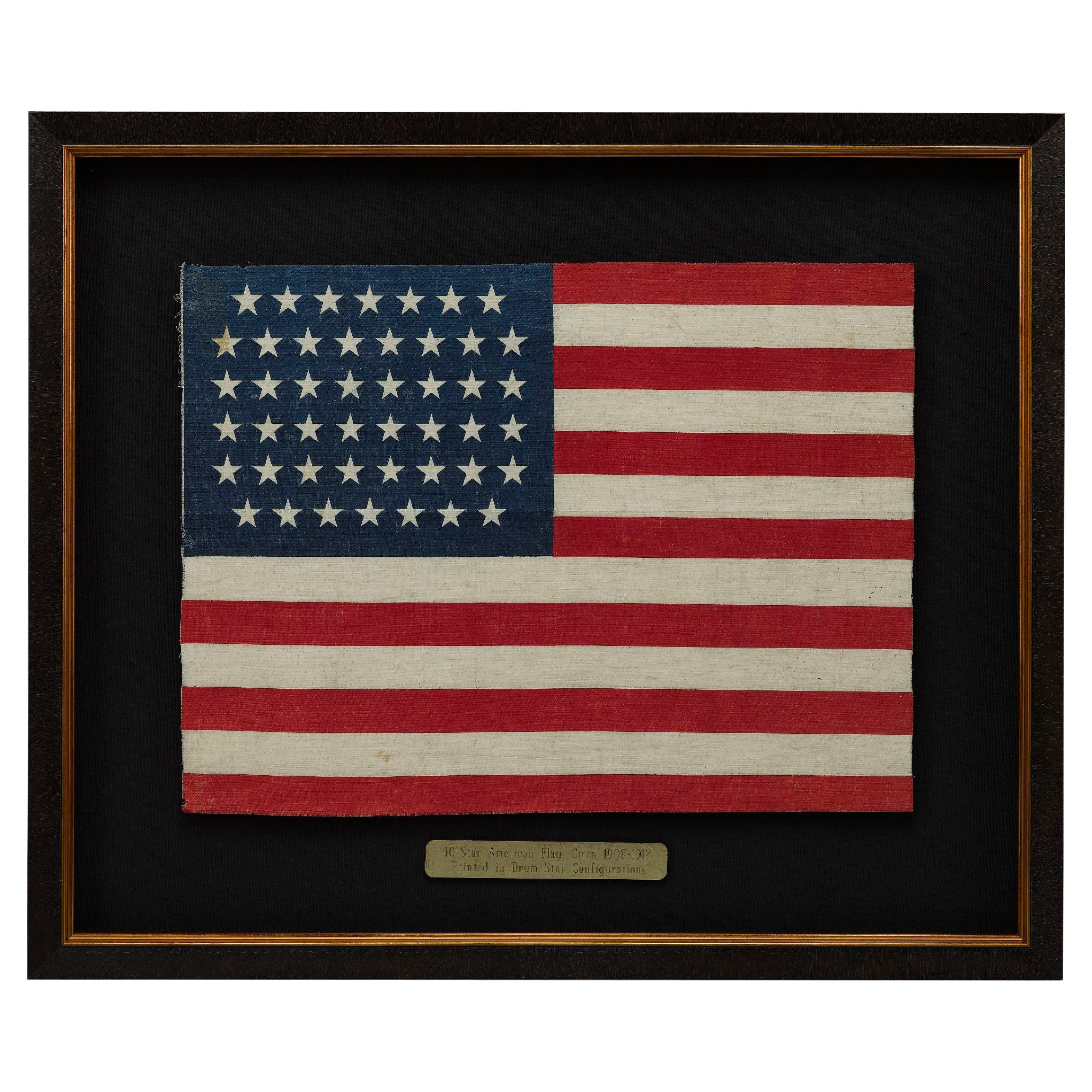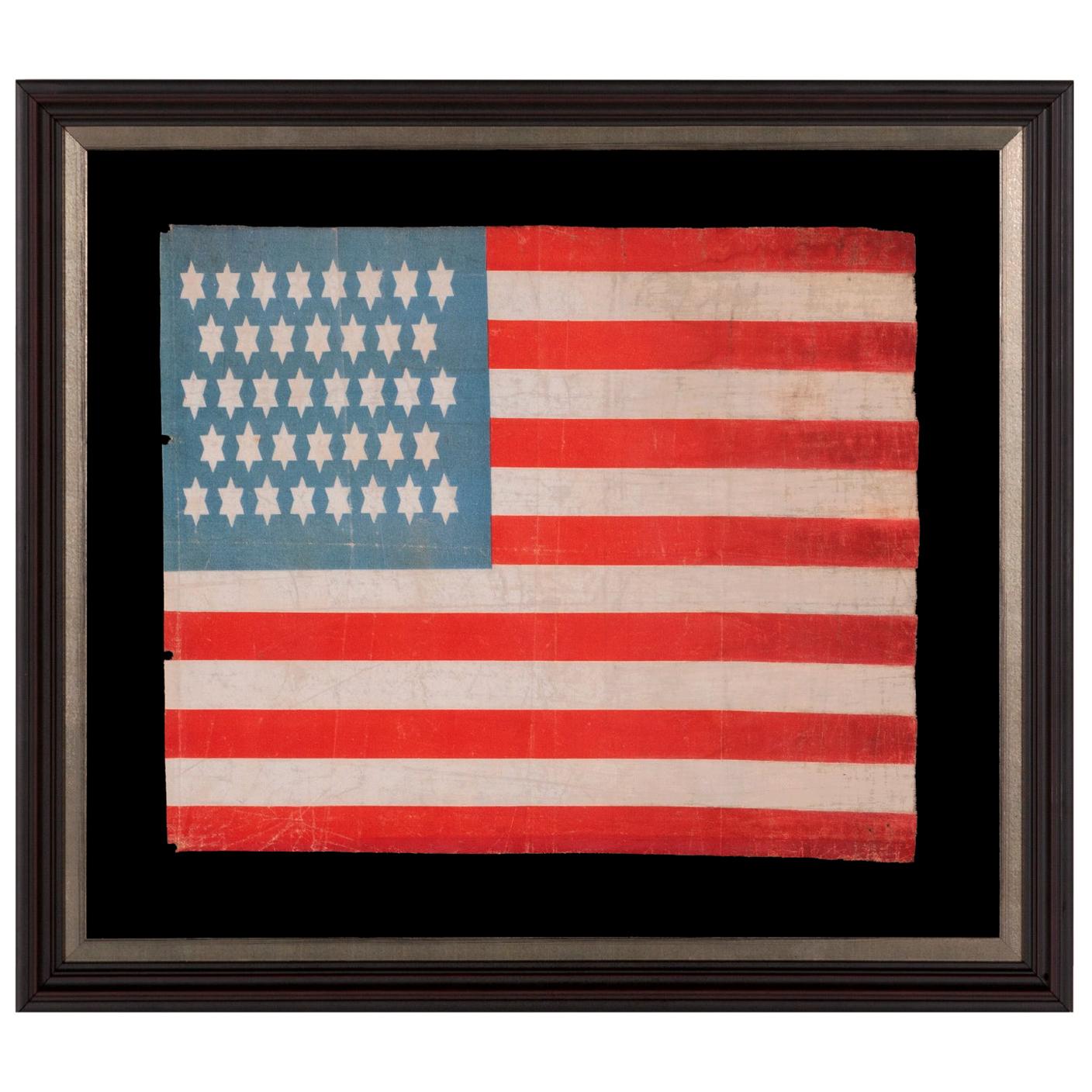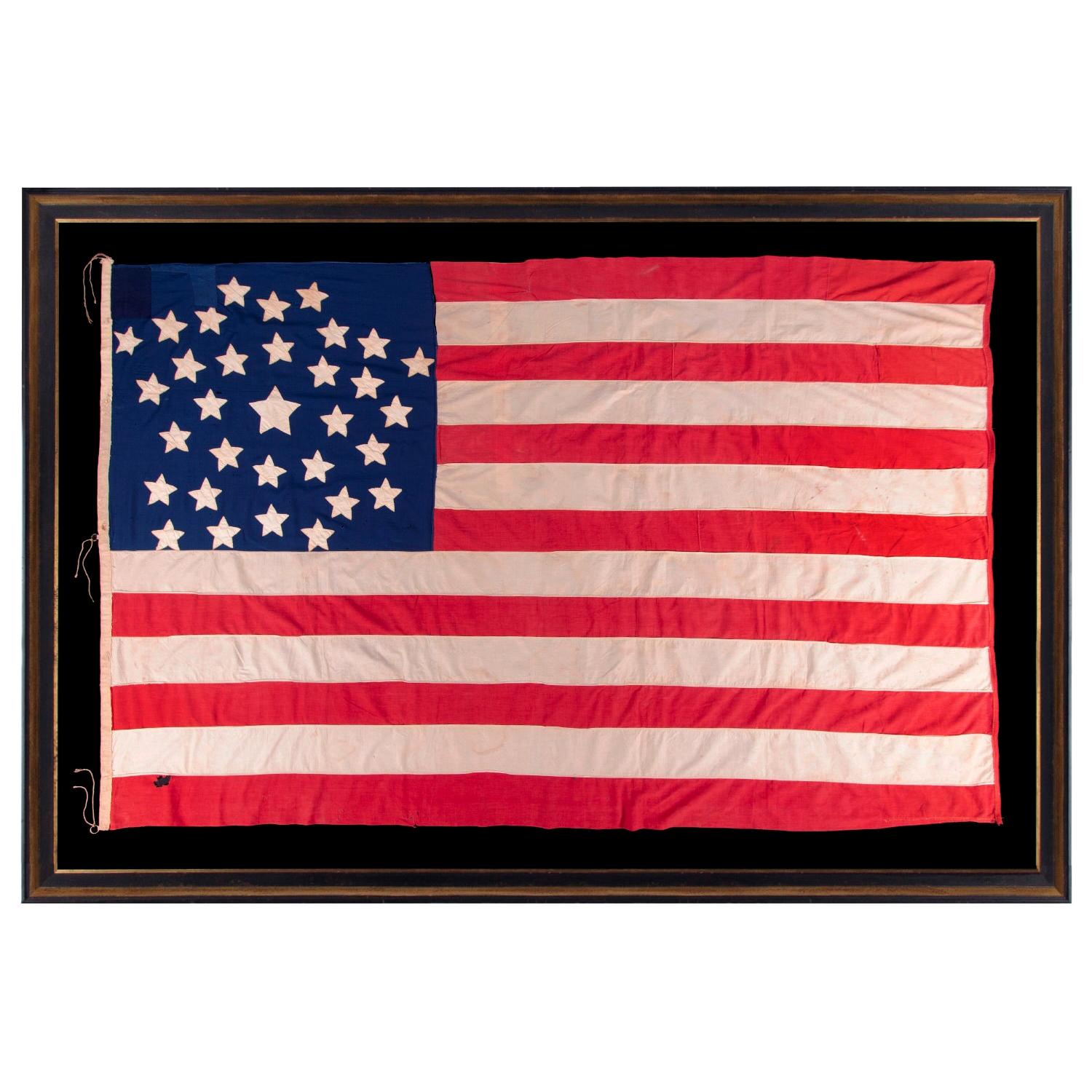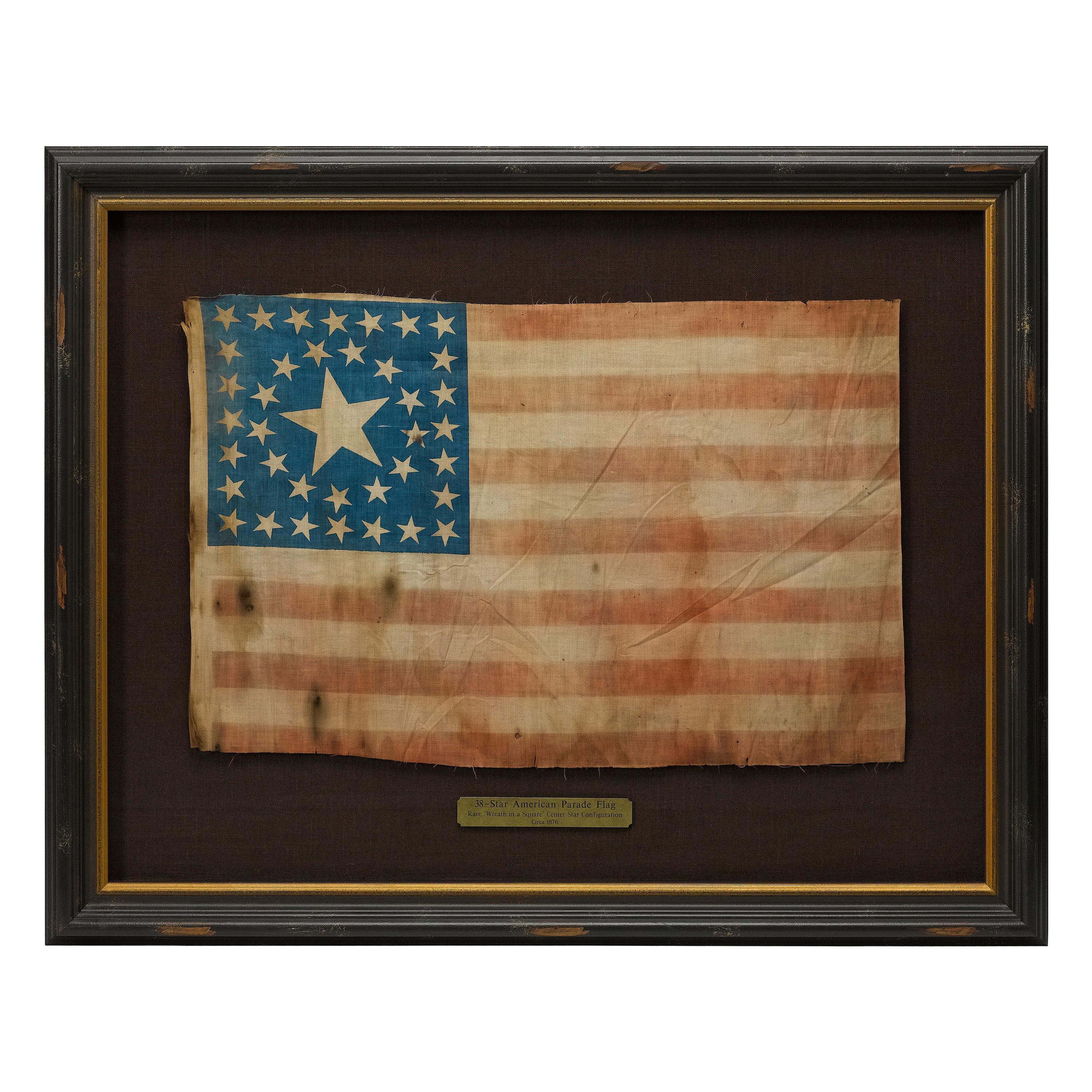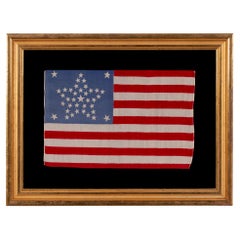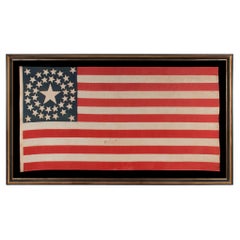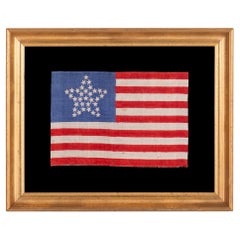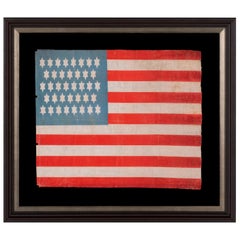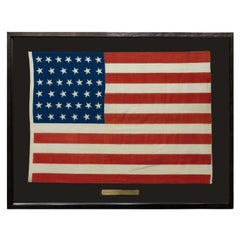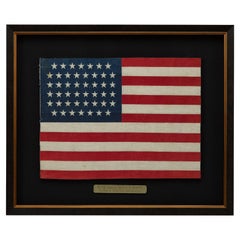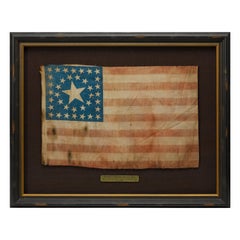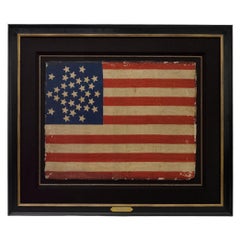Items Similar to 34 Star American flag, Updated to 39 Stars, with Stars in a Great Star Pattern
Want more images or videos?
Request additional images or videos from the seller
1 of 6
34 Star American flag, Updated to 39 Stars, with Stars in a Great Star Pattern
About the Item
34 STARS IN A WHIMSICAL RENDITION OF THE GREAT STAR PATTERN, ON A CIVIL WAR PERIOD FLAG WITH A CORNFLOWER BLUE CANTON, UPDATED TO 39 STARS IN 1876
34 star American national flag with additional stars added and one of the most stunning graphic designs I have ever seen in early flag-making. The original pattern was comprised of a circle of 5 large stars, and triangular arms made of smaller stars. These are noticeable pointy and bent like the arms of a starfish. Made of cotton, the stars are hand-sewn and double-appliquéd to a fantastic, cornflower blue canton, a color common to Civil War uniforms. The 34 state, Kansas, joined the Union in 1861, the opening year of the Civil War, and the 34 star flag was used until 1863. Five additional stars, even larger in size, were added, one in each corner and one in the very center. This probably occurred in 1876, for use at the celebration of our nation’s 100-year anniversary of independence. We received our 38th state in 1876, but 39 star flags were also being made at the time, in hopeful anticipation of the addition of another state. The 39th state did not come for another 13 years, which makes centennial-era 39 star flags both an oddity and a testament to American desire for continued growth.
Two of the 5 additional stars extend the already exaggerated arms of the star, furthering its already whimsical qualities. The result is a folk art masterpiece in early American flag-making.
The configuration’s basic design, a large star made out of smaller stars, has nearly countless variations. It is generally known as the "Great Star," but when it has an open center, like this flag once had before its center star was added, it has also been called the Great Flower. Among collectors, the Great Star configuration is the most coveted of all 19th century geometric patterns. Shortly after the War of 1812, American naval hero, Captain Samuel Reid, suggested to the president that the Great Star should be considered to become the first official star design. Reid’s primary concern was that, as more and more states joined the Union, our flag needed to be kept recognizable on the open seas. Naval use was the primary reason for the American ensign in the first place, and Reid’s proposal would have kept the star constellation in roughly the same form, and in an easily recognized design that could be quickly identified through a spyglass as the number of states grew.
Sadly, Reid’s proposal was rejected due to the increased cost of arranging the stars in this manner. Never-the-less, since there was no official star pattern, the great star was produced by anyone willing to make it. Its rarity today, along with its beauty, has driven the desirability of American flags with this configuration.
The stripes of the flag are made of cotton and sewn with a treadle machine. The canton is made of clothing grade wool. The original 34 stars are hand-sewn, while the added stars were appliquéd with a treadle machine. At the opening of the Civil War, the sewing machine was very new. Singer had mass-marketed it just 6 years prior. For this reason, people were not yet proficient in the skills needed to turn a piece of fabric, while folding under the edges of the fabric stars and pumping a treadle machine to appliqué them. By 1876, more persons had acquired this skill, though it was still more common for stars to be hand-sewn.
A cotton hoist is applied with hand-stitching and finished by treadle machine. The top of the canton is bound in the same manner as the hoist, which is highly unusual. This was probably because this length of wool was cut on all sides and thus had no selvedge to keep it from fraying. The wool would usually have been hemmed under in this case, but here the maker instead chose to apply a binding. Cotton ties are hand-sewn along the hoist so that the flag could be affixed to a staff.
Kansas was admitted into the Union as the 34th state on January 29th, 1861, about 2 ½ months before the Confederate assault on Fort Sumter that marked the beginning of the Civil War. The 34th star was officially added on July 4th of that year, but most flag makers would have added a 34th star with the addition of Kansas in January. The star count remained official until July 4th, 1863, and 34 star flags would have been produced until the addition of West Virginia in June of that year.
Mounting: The flag has not yet been mounted.
Flag size (H x L): 68" x 129".
- Dimensions:Height: 68 in (172.72 cm)Width: 129 in (327.66 cm)Depth: 1 in (2.54 cm)
- Materials and Techniques:
- Place of Origin:
- Period:
- Date of Manufacture:1876
- Condition:Wear consistent with age and use. See item Description.
- Seller Location:York County, PA
- Reference Number:Seller: 34j-8411stDibs: LU849718996292
About the Seller
5.0
Recognized Seller
These prestigious sellers are industry leaders and represent the highest echelon for item quality and design.
Established in 1991
1stDibs seller since 2008
69 sales on 1stDibs
Typical response time: 20 hours
- ShippingRetrieving quote...Shipping from: York County, PA
- Return Policy
Authenticity Guarantee
In the unlikely event there’s an issue with an item’s authenticity, contact us within 1 year for a full refund. DetailsMoney-Back Guarantee
If your item is not as described, is damaged in transit, or does not arrive, contact us within 7 days for a full refund. Details24-Hour Cancellation
You have a 24-hour grace period in which to reconsider your purchase, with no questions asked.Vetted Professional Sellers
Our world-class sellers must adhere to strict standards for service and quality, maintaining the integrity of our listings.Price-Match Guarantee
If you find that a seller listed the same item for a lower price elsewhere, we’ll match it.Trusted Global Delivery
Our best-in-class carrier network provides specialized shipping options worldwide, including custom delivery.More From This Seller
View All38 Star American Parade Flags with Stars in a Great Star Pattern
Located in York County, PA
38 STAR AMERICAN PARADE FLAG WITH A RARE AND BEAUTIFUL VARIATION OF THE “GREAT STAR” OR “GREAT FLOWER” PATTERN, 4 LARGE CORNER STARS, & AN ODD OUTLIER, 1876-1889, COLORADO STATEHOOD,...
Category
Antique Late 19th Century American Political and Patriotic Memorabilia
Materials
Silk
Price Upon Request
38 Star Antique Flag, Stars in Double Wreath Pattern, Colorado Statehood 1876-89
Located in York County, PA
38 STAR ANTIQUE AMERICAN FLAG WITH A DOUBLE-WREATH CONFIGURATION THAT FEATURES AN ENORMOUS CENTER STAR, REFLECTS THE PERIOD OF COLORADO STATEHOOD, 1876-1889:
38 star American national flag, made entirely of plain weave cotton. The stars are arranged in a medallion configuration. This features an enormous center star, surrounded by two wreaths of much smaller stars, with a flanking star in each corner of the blue canton. The sort of disparity here, present in the scale of the large star, versus those around it, is both exceptionally unusual and graphically dynamic.
Colorado became the 38th state on August 1st, 1876. This was the year of our nation’s centennial. Per the Third Flag Act of 1818, stars were not officially added until the 4th of July following a state's addition. For this reason, 37 remained the official star count for the American flag until part way through the following year. Flag-making was a competitive venture, however, and few flag-makers would have continued to produce 37 star flags when their competitors were making 38’s. Many flag-makers added a 38th star before Colorado entered the Union, in the early part of 1876, or possibly even prior. In fact, many makers of printed flags, called parade flags or hand-wavers, were actually producing flags in the 39 star count, in hopeful anticipation of the addition of two more Western Territories instead of one.
It is for these reasons that 38, 39, and 13 stars, to representing the original 13 colonies, are most often seen on flags displayed at the Centennial International Exhibition. Hosted in Philadelphia, this enormous event was our nation’s first World’s Fair, lasted for a duration of six months, and served as the nucleus of celebrations held to honor America’s 100-year anniversary of independence. The 38 star flag became official on July 4th, 1877 and was generally used until the 39th state was added in November of 1889.
This is probably a homemade flag, though sewn by a very skilled hand, or possibly, by two different individuals. The stripes are pieced and sewn entirely by hand, with remarkable care and precision. The canton is constructed of two lengths of blue fabric, that have been joined with treadle stitching. This was joined to the striped field by hand. The stars are double-appliquéd (applied to both sides) with treadle stitching. There is a treadle-sewn, cotton binding along the hoist, with five, hand-sewn grommets.
It is extremely unusual to encounter this combination of sewing methods. Soon after the sewing machine was mass-marketed, in the mid-1850’s, flag-makers both public and private made good use of treadle machines, to join stripes, when constructing American flags. During the Civil War (1861-65), most stripes were treadle-sewn. Stars were another matter. Until the advent of electric machines...
Category
Antique Late 19th Century American Political and Patriotic Memorabilia
Materials
Cotton
33 Star Flag with Stars in a "Great Star" Pattern, Oregon State, ca 1859-1861
Located in York County, PA
33 STARS IN A "GREAT STAR" PATTER ON A BRILLIANT, ROYAL BLUE CANTON, A RARE AND EXTRAORDINARY EXAMPLE, PRE-CIVIL WAR THROUGH THE WAR'S OPENING YEAR, 1859-1861, OREGON STATEHOOD
33 s...
Category
Antique Mid-19th Century American Political and Patriotic Memorabilia
Materials
Silk
38 Star Parade Flag with Whimsical 6-Pointed Stars, Colorado Statehood
Located in York County, PA
38 WHIMSICAL STARS, WITH 6-POINTED PROFILES, SIMILAR TO THE STAR OF DAVID, ON AN ANTIQUE AMERICAN FLAG OF THE CENTENNIAL ERA; A REMARKABLE SPECIMEN, ONE-OF-A-KIND AMONG KNOWN EXAMPLE...
Category
Antique Late 19th Century American Political and Patriotic Memorabilia
Materials
Cotton
Price Upon Request
39 Star Antique American Parade Flag with Stars in Two Sizes, Ca 1876
Located in York County, PA
39 STARS IN TWO SIZES, ALTERNATING FROM ONE COLUMN TO THE NEXT, ON AN ANTIQUE AMERICAN PARADE FLAG WITH AN UNUSUALLY ELONGATED PROFILE, DATING TO THE 1876 CENTENNIAL, NEVER AN OFFICI...
Category
Antique 1870s American Political and Patriotic Memorabilia
Materials
Cotton
Price Upon Request
34 Star Antique American Flag with Hourglass Medallion Stars, ca 1861-1863
Located in York County, PA
EXTRAORDINARY 34 STAR ANTIQUE AMERICAN FLAG WITH AN ACCORDION OR HOURGLASS MEDALLION CONFIGURATION THAT SURROUNDS A PENTAGON OF STARS IN THE CENTER; MADE OF FINE SILK AND ENTIRELY HAND-SEWN; MADE DURING THE OPENING YEARS OF THE CIVIL WAR (1861-63), IN A TINY SIZE AMONG ITS COUNTERPARTS OF THE PERIOD; REFLECTS THE ADDITION OF KANSAS AS THE 34TH STATE
34 star flag of the Civil War period with an array of rare, beautiful, and otherwise desirable features. Extremely small among flags of this period with pieced and sewn construction, the flag displays a star pattern that is not only highly unusual, but unique to this particular example. This consists of a single star in the very center, surrounded by a pentagon of stars, flanked by angular bracket of three stars to either side. Above and below are rows of 5 stars, followed by rows of 6 that line the top and bottom of the canton. The resulting configuration is what I have termed an “accordion medallion,” though “hourglass medallion” or “standing bow tie” would be perfectly acceptable.
When rotated 90 degrees, to view the harder-to-identify, bow tie formation, students of early star patterns may note the visual similarity between this and what I call “Starburst” or “Crosshatch” medallions. The pattern, however, conspicuously lacks the crosses of St. Andrew (a saltire) and St. George (roman cross), that would allow it to be more accurately categorized as such.
Entirely hand-sewn, the canton and stripes of the flag are made of fine silk. The hemming of this was accomplished with great skill. The top and bottom edges are selvedge. These are so similar in nature as to have come from the same maker. There is a white, silk binding along the hoist, in the form of an open sleeve, through which a length of braided hemp rope was passed, expertly looped and re-braided into itself at the top and bottom for strength.
The stars are made of white, polished cotton. These were stitched to both sides (double-appliqued). Note how the edges of the fabric were not turned under, providing evidence of the fact that the maker was not especially skilled in appliqueing. This was common, as applique work was far more difficult than producing French seams.
In the 19th century, most flags with pieced and sewn construction were 8 feet long and larger. A six-footer was considered small. Even military battle flags, carried on foot, measured 6’ x 6.5’, which translates into approximately 7’ x 7.5’ after framing, about the size of an average quilt and larger than can comfortably fit on a wall in a house with 8-foot ceilings and average width baseboard. Flags smaller than this were produced both commercially and at home, but the smaller they are, the more unusual they are. At just 26.5 x 46.5 inches, this flag is extremely small for a Civil war period flag with sewn construction.
Silk was both beautiful and lightweight, which made it elegant for military unit colors and preferable for flags meant to be carried on foot. Most outdoor use flags...
Category
Antique 1860s American Political and Patriotic Memorabilia
Materials
Silk
You May Also Like
39-Star Antique American Flag with 'Whimsical' Star Pattern, 1889
Located in Colorado Springs, CO
This is a 39-star unofficial American flag, handmade and printed on cotton. The flag dates to 1889 and has a unique history, thanks to its rare star-count.
The flag’s canton is prin...
Category
Antique 1880s American Political and Patriotic Memorabilia
Materials
Cotton
46-Star American Flag Printed in Drum Star Configuration
Located in Colorado Springs, CO
This is an original 46-Star American parade flag, celebrating Oklahoma statehood. Each star on the flag's canton represents a state in the Union at the time. The official flag design would update every July 4th, to include any new states added to the Union in the past year. Oklahoma, the 46th state, entered the Union on November 16, 1907. As such, this 46–star flag was the official flag of the United States from July 4, 1908, until July 4, 1912.
The silk flag has a dark blue canton with 46 white printed stars. The stars are printed in an 7-8-8-8-8-7 row configuration, or “Drum design.” The flag design is completed with 13 alternating red and white stripes, each stripe representing one of the original thirteen colonies.
The land that comprises Oklahoma today was added to the United States as part of the Louisiana Purchase of 1803. Throughout the 19th century, the U.S. government relocated Indian tribes from the southeastern United States to the area, and by 1900, over 30 Indian tribes had been moved to what was originally called the Indian Territories. At the same time, ranchers in Texas began to move into the area in search of new pasture lands. Although stipulations in the Indian Relocation Act agreed that the land would forever be Indian Territory, the promise of fertile farmland trumped the government’s promise of sovereignty.
On April 22, 1889, they opened the land to settlement by homesteaders, creating a land run in which settlers, called “Boomers,” were allowed to cross the Texas or Arkansas border at a particular hour to claim homesteads. Settlers who illegally crossed the border earlier to stake prime land were called “sooners,” which eventually became the state’s nickname. Wagons and the Santa Fe railroad carried cartloads of men and women to blank town sites and building plots, creating ten thousand-people communities in a matter of days. The following year, the region was further divided into Indian Territory and Oklahoma Territory...
Category
Vintage 1910s American Political and Patriotic Memorabilia
Materials
Silk
38-Star Antique American Flag with Unique Canton, circa 1876-1890
Located in Colorado Springs, CO
This is a striking 38-star American flag. The flag dates to 1876-1890, when Colorado (represented by the large star in the center of the flag’s canton) joined the Union as the 38th s...
Category
Antique Late 19th Century American Political and Patriotic Memorabilia
Materials
Muslin
31-Star Printed American Flag, Celebrating California Statehood, Circa 1850
Located in Colorado Springs, CO
This is a rare 31-star medallion printed American flag, celebrating the addition of California to the Union. The flag is printed on silk and has a spectacular “Great Star” canton pat...
Category
Antique 1850s American Political and Patriotic Memorabilia
Materials
Silk
Antique Federal Eagle American 50 Star Flag with Brass Eagle Pole, 19th Century
Located in Oklahoma City, OK
Monumental 50 star American Flag with antique Federal Eagle brass and wood pole. A patriotic piece suitable for any home. This set includes both ...
Category
Antique 19th Century American Federal Political and Patriotic Memorabilia
Materials
Brass, Bronze
$4,800 Sale Price
20% Off
King Edward VII Coronation, June 1902 Framed Red Flag
Located in Hastings, GB
King Edward VII coronation, June 1902 framed scarf / flag.
This scarf is an original antique piece of British history and patriotic memorabilia.
...
Category
Antique Early 1900s British Edwardian Political and Patriotic Memorabilia
Materials
Cotton
Recently Viewed
View AllMore Ways To Browse
Antique Fabric Patterns
Mounted American Flag
Antique Blue Canton
19th Century American Flag
Folk Art American Flag
Centennial 1876
Small American Flag
American Flag Cotton
Folk Art Applique
Wool Flag
War 1812
War Of 1812
Antique Hoist
Antique Pump
Antique Pumps
Antique Union Cases
Blue Star Flag
Civil War Memorabillia
